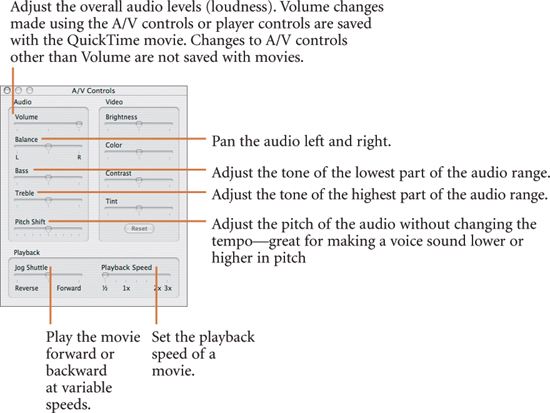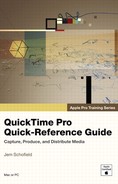Appendix C. QuickTime Player Quick Start
QuickTime Player is a freely distributed, cross-platform (Mac and PC) multimedia application. This appendix describes basic QuickTime Player functions such as controlling media playback attributes and presents timesaving keyboard shortcuts.
Using QuickTime Player
QuickTime Player is a freeware digital multimedia player for Macintosh and Windows-based computers that plays video, music and audio, and QuickTime virtual reality (VR) movie files. It also allows you to view graphics and still images in a variety of formats.
QuickTime Player allows the live resizing of video content as it’s played, it supports up to 24 channels of surround audio, and it provides extensive audiovisual controls that let you adjust such parameters as volume, pitch, brightness, and color. With the A/V controls, you can also select the overall playback speed and direction (reverse and forward).
QuickTime Player also includes zero-configuration streaming and a browser plug-in. Zero-configuration streaming automatically chooses the best online connection speed when you view streaming content. The browser plug-in lets you seamlessly view QuickTime-supported content on the Web.
Choosing Present Movie Options
Present Movie lets you control the playback of movies in Full Screen mode. This feature allows you to present a QuickTime file in other than the default configuration.
Choose View > Present Movie to display the Present Movie dialog.

Using A/V Controls
If you are using QuickTime Pro with Windows or with Mac OS X version 10.4 or higher and have a video card capable of core image processing, the A/V Controls window will display video options that let you adjust brightness, color, contrast, and tint. An additional audio adjustment, Pitch Shift, is also available.
Choose Window > Show A/V Controls to adjust the settings.

Upgrading to QuickTime Pro
You must have the latest version of Apple’s free QuickTime Player before you can upgrade to QuickTime Pro. The player is available for Macintosh and Windows at www.apple.com/quicktime.
After you have downloaded and installed QuickTime Player, you have two options for upgrading to QuickTime Pro. If you’re using a Macintosh, choose QuickTime Player > Buy QuickTime Pro; on a Windows computer, choose Help > Buy QuickTime Pro. You can also go to www.apple.com/quicktime and follow the Upgrade Now instructions. Using these methods, you will be able to purchase your QuickTime Pro registration code in the Apple Online Store.
You will receive a registration code via email; then you’ll need to follow the instructions to install the QuickTime Pro registration key.
To verify that you’ve upgraded to QuickTime Pro successfully, look at the QuickTime Player menus. They should no longer display any dimmed options. This means that all the features of QuickTime Pro are now available.
Registration codes from previous versions of QuickTime Pro do not work with the latest version.
Keyboard Shortcuts
The following table presents keyboard shortcuts that you can use for your work in QuickTime. Macintosh shortcuts are shown first, followed by shortcuts for Windows.



